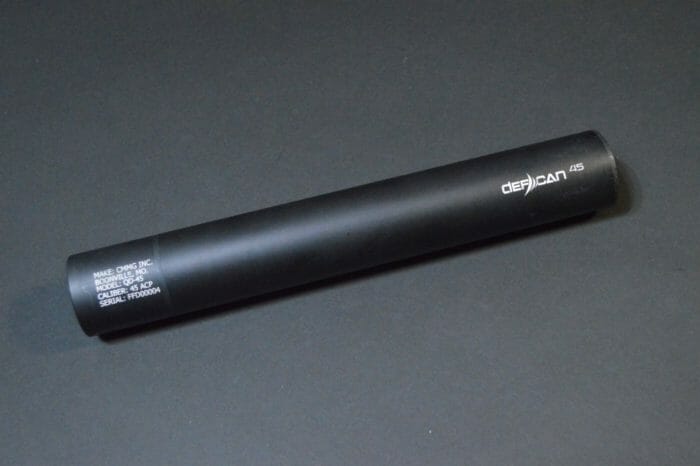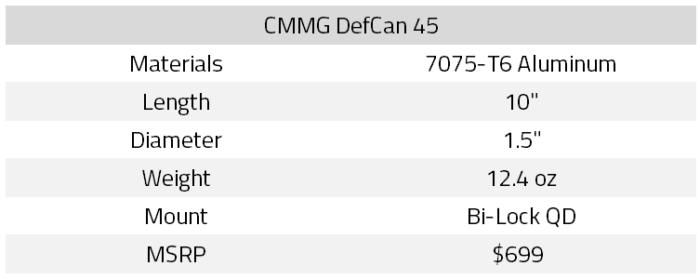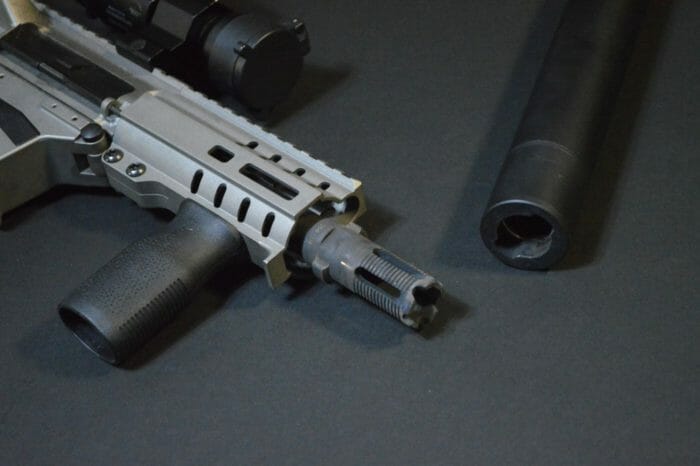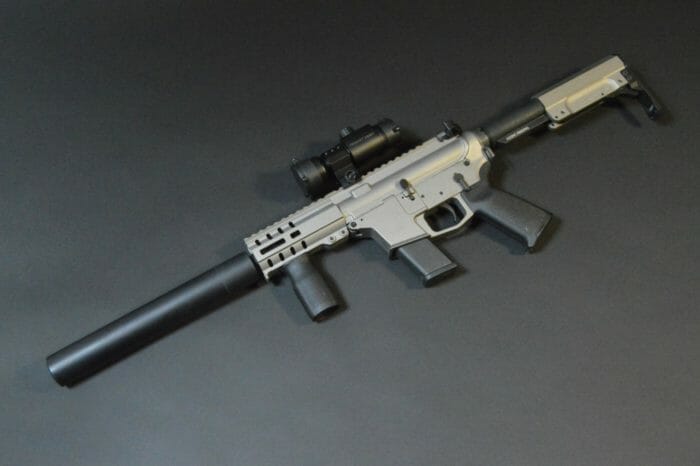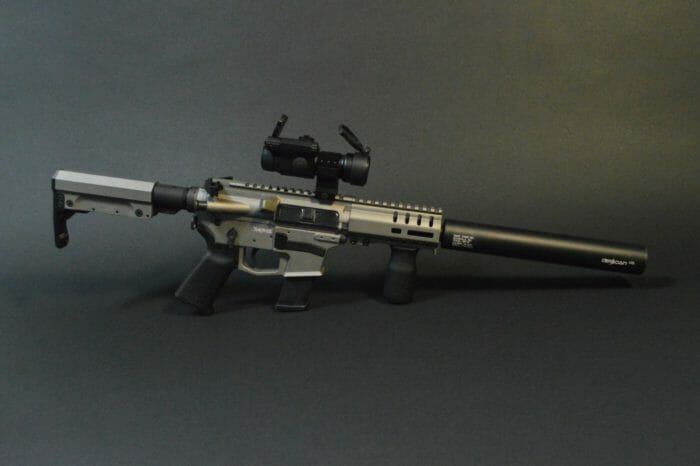Silencer Shop Authority: CMMG DefCan 45 Review
When an industry friend tipped me off earlier this year regarding CMMG’s plans to hop into the suppressor market, I was very surprised. Sure, CMMG is one of the most innovative AR-15 makers out there, but silencers just seemed like a massive departure from their core product, and honestly, my expectations were quite low because of that. That wasn’t necessarily fair.
Those of you who have read my CMMG DefCan 9 review are probably already aware that it was a delightful surprise – particularly as an inaugural offering. Fortunately for me, the folks at Silencer Shop sent along with the DefCan 9’s brother in the same package, and for that reason, let’s take a closer look at the similar, but not at all identical, DefCan 45.
Size & Weight
It may not be immediately clear, especially because they belong to the same line of suppressors, but the DefCan 9 and 45 depart from one another in some very significant ways. It’s somewhat expected that the .45 rendition of a can will be longer and heavier. That holds here with the DefCan 45 measuring up at 10” long and weighing in at a not-too-bad 12.4 ounces. For reference, my SilencerCo Octane 45 weighs roughly 12.1 ounces.
There’s an explanation for the ~2.5-ounce difference between the DefCan 9 and the 45 that goes beyond the mere 0.25” length discrepancy. You see, the .45 is 1.5” in diameter instead of 1.38”. For this reason, it doesn’t need to be a whole lot longer than the 9mm version to offer solid performance. The DefCan 45’s 1.5” diameter is more in line with traditional subgun suppressors.
Materials & Design
From a design standpoint, the CMMG DefCan 45 is quite similar to the 9mm. Sure, it’s bigger, but it features the same all-aluminum (7075-T6) construction that we saw before. This might concern some buyers, especially considering the DefCan is not user-serviceable. I can sympathize with this line of thinking, too. Having seen some really dirty pistol suppressors (even ones not used with cast lead rounds), I would strongly prefer the DefCan to be serviceable. There’s certainly a trend in the subgun suppressor market that’s moving away from silencers that can be opened up for cleaning – the Dead Air Wolf-9SD and SilencerCo Omega 9K come to mind – but unlike the stainless steel competition, the DefCan’s aluminum doesn’t lend itself to harsh cleaning agents that can be used to clear out debris inside the tube.
One of my favorite features of the DefCan is its Bi-Lock mount. The Bi-Lock system isn’t new. Gemtech has used it for years, but they don’t own the patent for it. That’s actually held by Greg Latka of GSL Technologies. Working with Greg, CMMG brought the Bi-Lock to their DefCan line and they were absolutely wise to do so. It works much like the 3-lug system (also created by Latka), but as the name implies has only two (extra beefy) lugs. To attach the suppressor the included flash hider mount, simply slide it over the lugs, compress the internal spring, twist 90-degress in either direction, and release. It’s quick and very secure.
Range Report
There’s no question that the CMMG DefCan 45 is a very solid performer. According to recent data from YouTuber Buffman R.A.N.G.E., the can runs at around 131 dB at both the muzzle and the ear when used with CMMG’s Banshee MkG 45. Fortunately, I was able to test the can with that very host and can confirm the results that Matt observed. It is perhaps not as quiet as the phenomenal Rugged Suppressors Obsidian 45, but it is still among the best .45 ACP performers I’ve tried. Moreover, the added girth of the tube helped to give the DefCan an inoffensive tone. Combine this with low backpressure (partially due to the Banshee’s design), and I had no problem slinging lead in an extended range session with no additional hearing protection (I’m not necessarily recommending shooting without muffs).
Though the DefCan 45 was excellent on the Banshee 45, it was even better on the Banshee MkGs 9mm. The added volume of the suppressor over CMMG’s 9mm DefCan made a world of difference. Unfortunately, I don’t have numbers for this combo, but it was incredible. The tone might have been fooling me, but I expect that the DefCan 45 could meter as low as 125 dB at the ear with an optimized 9mm host like the Banshee.
The .45 version of the DefCan fell victim to the same sort of accuracy challenges that were present with the 9mm rendition. For reasons completely unknown to me, mounting the DefCan to the Banshee MkG caused the point of impact (POI) to drop by nearly two inches at just 25 yards. Careful inspection of the can revealed no obvious signs of damage like baffle or end cap strikes, so the phenomenon is difficult/impossible to explain. Moreover, the Bi-Lock mounting requirements precluded me from easily testing the can on my Zenith Z-5RS to see if the issues continued. My suspicion is that either the mount or the length of the DefCan (when paired with the much shorter Banshee barrel) are to blame.
You’ll probably notice on the video that the CMMG DefCan 45 does have some first-round pop (FRP). It’s a large suppressor, and big silencers are known to be a little loud in this regard. Even so, it’s still quite pleasant and certainly better than monocore designs. I estimated around 4 dB of FRP when I tested the DefCan, and sure enough, Matt’s numbers support that almost to a tee.
Conclusion
There’s a whole lot to love about the CMMG DefCan 45 and only a few things to dislike. Let’s start with the bad news. First, it isn’t end-user serviceable. Even for a centerfire can, that’s not ideal. Second, it’s entirely aluminum. This isn’t such a major issue if you can’t clean the suppressor because it isn’t like most will use harsh cleaners anyway. The weight savings might be worthwhile. Third, DefCan is rather long. At 10” it passes just about every other competitor in terms of length. Those three details are it as far as negatives go.
On the positive side of the coin, the DefCan 45 sounds phenomenal. It’s fantastic on a .45 ACP host like the CMMG Banshee, but it’s even better with a 9mm firearm and some subsonic ammunition. The DefCan is also light for its size. Thanks to the aluminum build, it is roughly the same weight as my SilencerCo Octane 45 while being substantially larger. Lastly, the Bi-Lock mount is fantastic. I’m still not clear on whether or not the mount is responsible for the POI shift, but I kind of doubt it. The system has been around for a long time, and I haven’t heard anyone complain about repeatability. On the whole, the CMMG DefCan 45 is a solid, competitive suppressor in one of the least crowded (but growing more so) spaces of the market.
If you’re interested in grabbing a CMMG DefCan 45 for yourself, Silencer Shop is the place to find it. Expect to pay around $679 for it, but price may vary between Powered By dealers.
An information security professional by day and gun blogger by night, Nathan started his firearms journey at 16 years old as a collector of C&R rifles. These days, you’re likely to find him shooting something a bit more modern – and usually equipped with a suppressor – but his passion for firearms with military heritage has never waned. Over the last five years, Nathan has written about a variety of firearms topics, including Second Amendment politics and gun and gear reviews. When he isn’t shooting or writing, Nathan nerds out over computers, 3D printing, and Star Wars.

